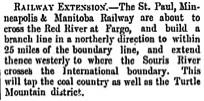In the Turtle Mountain district, as elsewhere in Manitoba in the 1880’s, the talk was always of railways. The newspapers were filled with the topic. There were reports, rumours, and rumours of reports concerning railway charters. There were even some railway surveys, and, but much less often, actual railway building.
There was considerable wishful thinking in all of this, but there was also a very real need. This amazing transportation system had been developed, with its potential to facilitate the transformation of an entire landscape, and to enable a whole generation of new farmers to realize the dream of being independent producers in a new land. It was real, it was up and running elsewhere, but it was just outside our grasp.
The delays led to competing schemes.

And there were more…
The The Turtle Mountain and Rock Lake Railway Company proposed a line directly west from Emerson. The Brandon Souris and Turtle Mountain Railway Company was chartered to run from Brandon to the Turtle Mountain region then west. The Turtle Mountain and Manitoba Railway Company was incorporated to connect the area with Virden and the Northwest Territories (later Saskatchewan). The Winnipeg Daily Sun reported in 1882 that an, “…annual meeting of the Valley City and Turtle Mountain Railway was held in Valley City.” They were advancing the idea that the Turtle Mountain region should “tap the Northwestern system.”
At the heart of all this speculation was the reality of the CPR monopoly, granted as part of the contract to build a transcontinental railway, and the hope that the Manitoba government would succeed in getting the Dominion Government to change that.
While many of the railway proposals may have been based more on hopes than on available investors, most were practical, indeed modest, attempts to address a local Manitoba need.

Railway construction on the prairies. (Photo from Archives of Manitoba.)
One idea in particular, however, did verge on the fanciful.
In late 1883 a delegation appeared before Winnipeg City Council seeking a grant to explore the feasibility of the “San Francisco, Winnipeg and Hudson Bay Railway.” The proposed route would run from, “Ogden Utah, in a northeasterly direction to Hudson’s Bay at Port Nelson. It strikes Manitoba near the Turtle Mountains”. One of its many selling points was that it would “bring San Francisco 1000 miles nearer Europe than the route afforded by the Central Pacific road through Chicago.”
This scheme was not the only one based on a faith that Hudson’s Bay, as it had been the hub of trade in the Fur Trade era, would be the shipping centre of the future. And as fanciful as the idea seems, it is important to remember that Canada had just acquired the former Hudson’s Bay Company territory, the entire area west of Lake Superior, just over a decade earlier, and that it was natural for many in the region to think of north-south transportation links. In fact railway baron J.J. Hill was soon to propose a canal from Lake Superior to Hudson Bay.
One must admit that the entrepreneurs of the day were not afraid to think big.
Of all the schemes thrown out there in the first half of the 1880’s, only one was built in the Turtle Mountain region in that era. In 1885 the C.P.R. after taking over the proposed Manitoba and Southwestern Railway finally made it as far as the crossing of Cherry Creek and the town of Boissevain was created overnight.
The truth was that the settlers didn’t need ALL of the proposed railways, but they certainly need A railway.
. . . . .
Author: Ken Storie
Sources:
Winnipeg Times. 25 Feb. 1880 Winnipeg Daily Sun. 11 Sept. 1882, 19 Dec. 1883, 26 Jan. 1884, 3 June 1884 The Brandon Sun. 17 July 1884, 10 Sept. 1885 85
